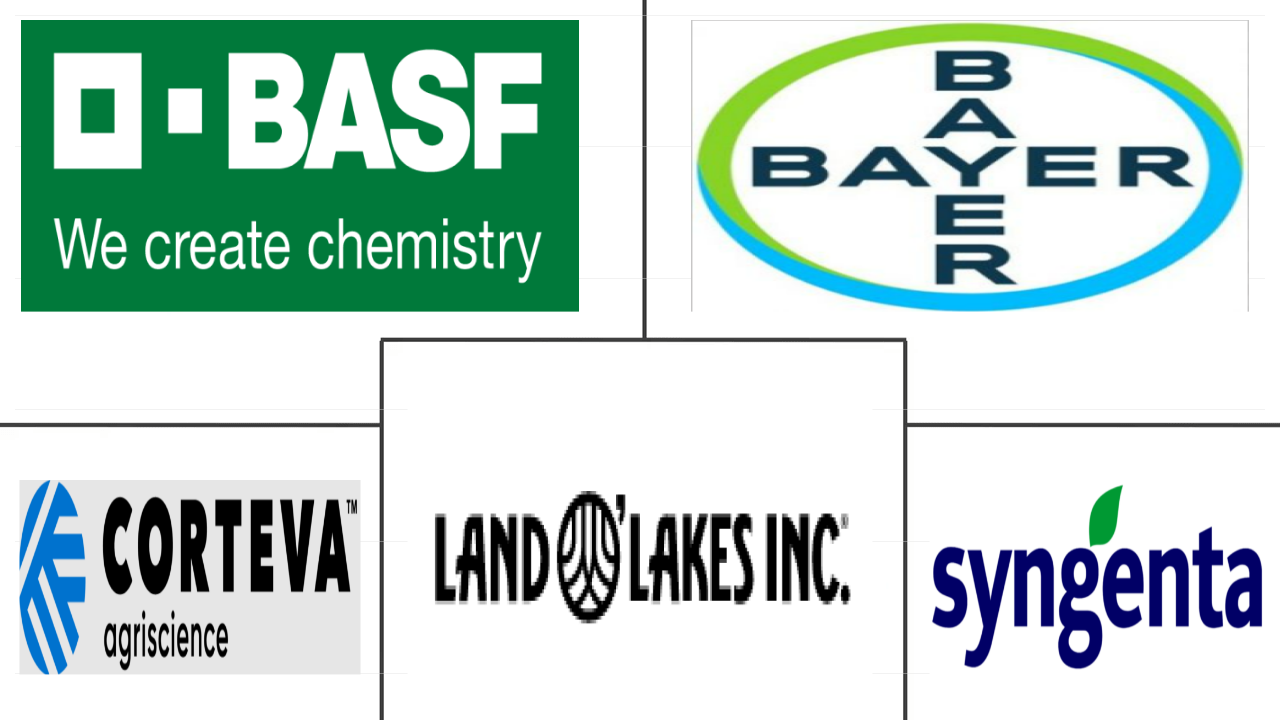Market Size of united states seed Industry
|
|
Study Period | 2017 - 2030 |
|
|
Market Size (2024) | USD 19.64 Billion |
|
|
Market Size (2030) | USD 29.09 Billion |
|
|
Largest Share by Breeding Technology | Hybrids |
|
|
CAGR (2024 - 2030) | 6.76 % |
|
|
Fastest Growing by Breeding Technology | Hybrids |
Major Players |
||

|
||
|
*Disclaimer: Major Players sorted in no particular order |
United States Seed Market Analysis
The United States Seed Market size is estimated at 19.64 billion USD in 2024, and is expected to reach 29.09 billion USD by 2030, growing at a CAGR of 6.76% during the forecast period (2024-2030).
19.64 Billion
Market Size in 2024 (USD)
29.09 Billion
Market Size in 2030 (USD)
8.45 %
CAGR (2017-2023)
6.76 %
CAGR (2024-2030)
Largest Market by Crop Family
64.29 %
value share, Grains & Cereals, 2023
It is the largest segment as the United States is one of the largest producers of corn and wheat globally and has higher adoption of improved cultivars and transgenic hybrids.
Largest Market by Breeding Technology
84.06 %
value share, Hybrids, 2023
It is due to the majority of areas under transgenic hybrids in the case of corn, soybean, alfalfa, and canola. Also, higher adoption of non-transgenic hybrids in other crops.
Fastest-growing Market by Crop Family
7.77 %
Projected CAGR, Solanaceae, 2024-2030
It is the fastest growing segment in the region because of the increasing demand for vegetables as they are a rich source of nutrients and the development of improved varieties.
Fastest-growing Market by Breeding Technology
6.81 %
Projected CAGR, Hybrids, 2024-2030
Due to inherent characteristics such as high vigor, resistance to biotic and abiotic stresses, high yield, and uniform maturity, the hybrid segment is growing at the fastest rate.
Leading Market Player
20.55 %
market share, Corteva Agriscience, 2022

The company has made extensive product innovations and effective partnership strategies. It has recently launched its new gene-editing technology in corn hybrids and other crops.
Hybrids dominated the segment with higher adoption of transgenic hybrids in corn and soybean
- In the United States, hybrids had a larger share in the country's seed market as growers prefer hybrids to earn high profits and obtain higher yields. In 2022, hybrids accounted for 84.0% of the seed market, whereas open-pollinated varieties and hybrid derivatives accounted for 16.0% in 2022, mainly due to the enhanced yield and pest resistance offered by hybrids.
- Among the hybrids, corn is the major crop sown in the country, and hybrid seeds contributed 87.7% of the total US corn seed market in 2022. The high share is associated with the increased use of double-cross hybrids, higher adoption of transgenic hybrids, and demand from livestock producers as feed.
- The use of transgenic hybrids is increasing in the country due to the increasing demand for animal feed and the demand from the processing industry to produce various end products, including corn starch, soybean oil, and canola oil. This demand is compensated by transgenic hybrids, which had a share of 75.1% in hybrids in 2022.
- Tomato is estimated to be the fastest-growing sub-segment in the US hybrid seed market, with a CAGR of 8.3% during the forecast period, as there is high demand for tomatoes in the country for consumption and processing industries.
- However, the increasing low-cost open-pollinated varieties, their adaptability to different climatic conditions, and the reduced timely availability of hybrids in all the crops are boosting the demand for open-pollinated varieties in the country.
- An increase in the livestock production and consumption of meat in the country, increasing demand for disease and pest-resistant varieties, increasing demand from the processing industries, and low cost of open-pollinated varieties are driving the demand for new types of hybrids and open-pollinated varieties.
United States Seed Industry Segmentation
Hybrids, Open Pollinated Varieties & Hybrid Derivatives are covered as segments by Breeding Technology. Open Field, Protected Cultivation are covered as segments by Cultivation Mechanism. Row Crops, Vegetables are covered as segments by Crop Type.
- In the United States, hybrids had a larger share in the country's seed market as growers prefer hybrids to earn high profits and obtain higher yields. In 2022, hybrids accounted for 84.0% of the seed market, whereas open-pollinated varieties and hybrid derivatives accounted for 16.0% in 2022, mainly due to the enhanced yield and pest resistance offered by hybrids.
- Among the hybrids, corn is the major crop sown in the country, and hybrid seeds contributed 87.7% of the total US corn seed market in 2022. The high share is associated with the increased use of double-cross hybrids, higher adoption of transgenic hybrids, and demand from livestock producers as feed.
- The use of transgenic hybrids is increasing in the country due to the increasing demand for animal feed and the demand from the processing industry to produce various end products, including corn starch, soybean oil, and canola oil. This demand is compensated by transgenic hybrids, which had a share of 75.1% in hybrids in 2022.
- Tomato is estimated to be the fastest-growing sub-segment in the US hybrid seed market, with a CAGR of 8.3% during the forecast period, as there is high demand for tomatoes in the country for consumption and processing industries.
- However, the increasing low-cost open-pollinated varieties, their adaptability to different climatic conditions, and the reduced timely availability of hybrids in all the crops are boosting the demand for open-pollinated varieties in the country.
- An increase in the livestock production and consumption of meat in the country, increasing demand for disease and pest-resistant varieties, increasing demand from the processing industries, and low cost of open-pollinated varieties are driving the demand for new types of hybrids and open-pollinated varieties.
| Breeding Technology | ||||||||
| ||||||||
| Open Pollinated Varieties & Hybrid Derivatives |
| Cultivation Mechanism | |
| Open Field | |
| Protected Cultivation |
| Crop Type | |||||||||||||||||||||||||||||||||
| |||||||||||||||||||||||||||||||||
|
United States Seed Market Size Summary
The United States seed market is experiencing significant growth, driven by the increasing demand for hybrid seeds, particularly in crops like corn and soybeans. Hybrids dominate the market due to their higher yields and pest resistance, with corn being the major crop sown using hybrid seeds. The adoption of transgenic hybrids is also on the rise, fueled by the demand from livestock producers and the processing industry for products such as corn starch and soybean oil. While hybrids hold a substantial share, there is a growing interest in open-pollinated varieties due to their adaptability and cost-effectiveness. The market is characterized by a moderate level of consolidation, with major players like BASF, Bayer, Corteva, Land O’Lakes, and Syngenta leading the industry.
The cultivation of row crops, including corn, soybeans, and cotton, plays a crucial role in the United States' agricultural landscape, with these crops occupying a significant portion of the harvested acreage. The demand for oilseeds and fiber crops is anticipated to drive further expansion in these areas, supported by the country's position as a leading producer and exporter. The market is also witnessing innovation in vegetable seeds, with companies developing new traits to meet the evolving needs of growers. This dynamic environment is expected to sustain the market's growth trajectory, as evidenced by recent developments such as BASF's expansion of its soybean seed portfolio and Syngenta's investment in R&D for regenerative agriculture.
United States Seed Market Size - Table of Contents
-
1. MARKET SEGMENTATION (includes market size in Value in USD, Forecasts up to 2030 and analysis of growth prospects)
-
1.1 Breeding Technology
-
1.1.1 Hybrids
-
1.1.1.1 Non-Transgenic Hybrids
-
1.1.1.2 Transgenic Hybrids
-
1.1.1.2.1 Herbicide Tolerant Hybrids
-
1.1.1.2.2 Insect Resistant Hybrids
-
1.1.1.2.3 Other Traits
-
-
-
1.1.2 Open Pollinated Varieties & Hybrid Derivatives
-
-
1.2 Cultivation Mechanism
-
1.2.1 Open Field
-
1.2.2 Protected Cultivation
-
-
1.3 Crop Type
-
1.3.1 Row Crops
-
1.3.1.1 Fiber Crops
-
1.3.1.1.1 Cotton
-
1.3.1.1.2 Other Fiber Crops
-
-
1.3.1.2 Forage Crops
-
1.3.1.2.1 Alfalfa
-
1.3.1.2.2 Forage Corn
-
1.3.1.2.3 Forage Sorghum
-
1.3.1.2.4 Other Forage Crops
-
-
1.3.1.3 Grains & Cereals
-
1.3.1.3.1 Corn
-
1.3.1.3.2 Rice
-
1.3.1.3.3 Sorghum
-
1.3.1.3.4 Wheat
-
1.3.1.3.5 Other Grains & Cereals
-
-
1.3.1.4 Oilseeds
-
1.3.1.4.1 Canola, Rapeseed & Mustard
-
1.3.1.4.2 Soybean
-
1.3.1.4.3 Sunflower
-
1.3.1.4.4 Other Oilseeds
-
-
1.3.1.5 Pulses
-
-
1.3.2 Vegetables
-
1.3.2.1 Brassicas
-
1.3.2.1.1 Cabbage
-
1.3.2.1.2 Carrot
-
1.3.2.1.3 Cauliflower & Broccoli
-
1.3.2.1.4 Other Brassicas
-
-
1.3.2.2 Cucurbits
-
1.3.2.2.1 Cucumber & Gherkin
-
1.3.2.2.2 Pumpkin & Squash
-
1.3.2.2.3 Other Cucurbits
-
-
1.3.2.3 Roots & Bulbs
-
1.3.2.3.1 Garlic
-
1.3.2.3.2 Onion
-
1.3.2.3.3 Potato
-
1.3.2.3.4 Other Roots & Bulbs
-
-
1.3.2.4 Solanaceae
-
1.3.2.4.1 Chilli
-
1.3.2.4.2 Eggplant
-
1.3.2.4.3 Tomato
-
1.3.2.4.4 Other Solanaceae
-
-
1.3.2.5 Unclassified Vegetables
-
1.3.2.5.1 Asparagus
-
1.3.2.5.2 Lettuce
-
1.3.2.5.3 Okra
-
1.3.2.5.4 Peas
-
1.3.2.5.5 Spinach
-
1.3.2.5.6 Other Unclassified Vegetables
-
-
-
-
United States Seed Market Size FAQs
How big is the United States Seed Market?
The United States Seed Market size is expected to reach USD 19.64 billion in 2024 and grow at a CAGR of 6.76% to reach USD 29.09 billion by 2030.
What is the current United States Seed Market size?
In 2024, the United States Seed Market size is expected to reach USD 19.64 billion.

